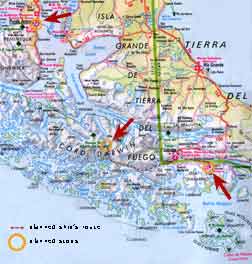see full size






Juan, First Mate

Scott and Mike,
Film Crew

Martin, Ocean
Tramp cook

Klara, Ocean
Tramp cook

Date: Saturday, February 26th 2005
Time: 11:45 am
Location: Puerta Williams
Temperature: 7°C 45°F
Wind speed: 50 mph 43.4 knots
Wind chill: 17°F
Water Temperature: N/A
Altitude: 10m
Weather: Constant wind and heavy rain
Distance Sailed: 0 miles
We have just arrived in Puerto Williams after a 40-hour ferry ride! The ride was only supposed to be 24 hours long, but strong winds and heavy seas made our progress very slow. The ferry itself is very wide and open to the elements, much like a cargo vessel. There is only one private passenger cabin onboard; everyone else is squeezed into a long thin room full of plastic-covered seats. The reason for the plastic seats became clear once we were underway; the bathroom is located at the far end of the cargo deck and the combination of breaking waves, sea spray, and driving rain guarantee you will be thoroughly soaked by the time you have answered the call of nature.
The food onboard was just as impressive… slightly stale wonder bread, processed cheese slices, and processed ham, all nicely warmed in the ships microwave. We had this delicious feast for breakfast, for lunch, and for dinner! We did get something more original when the seas calmed down a bit. It must be difficult to cook when you are being thrown around. The cargo deck of the ferry was very colorful, it contained everything from cars and trucks, bales of hay, chemical containers, building materials, food, and even a number dogs who whined loudly as the ferry slammed against the waves.
Needless to say, we were very relieved to arrive at Puerto Williams. Charlie Porter greeted us with a smile as we walked off the ferry. It takes a few hours before the unloading of the ferry begins so we headed to the dock to see Charlie’s boat: Ocean Tramp.
Ocean Tramp is a lovely-looking custom-designed vessel; it is one of only two of its kind in the world. The aluminum hull is reinforced for polar exploration with a double-thickness bottom. It is 21m long with a 6m beam and only draws 2.1m. It is a cutter rig ketch design with an added pilothouse. It’s water tanks can hold 5000 liters and it carries 4000 liters of fuel giving it a 4000 nautical mile range. The power plant is a 230 hp Perkins diesel with a 32 inch prop. It has a roller furling jib and genoa. It also has 3 radars, 2 echo sounders, 3 gps units, 3 zodiacs, and four 15 hp outboard motors. The boat is designed to sleep 15, but that might be a bit of a squeeze. We will be traveling with ten on board: Charlie Porter (Captain), Juan (First Mate), Paul, Andrei, Eric, Dan (Science Crew), Scott, Mike (Film Crew), Martin and Klara (Cooks). It is very spacious onboard and the only time that you realize there are ten people around is at meal times when you are all squeezed around the table.
After meeting everyone onboard Ocean Tramp over a hot cup of tea, we returned to the ferry to unload all of our gear. Thankfully, Charlie owns quite a large truck so we were able to move all our gear in only two trips. Back at the dock we began the long slow process of fitting all our gear inside Ocean Tramp.
Previous entry, Next entry return to Patagonia home

 This project is supported by a grant from NOAA, Office of Global Programs
This project is supported by a grant from NOAA, Office of Global Programs